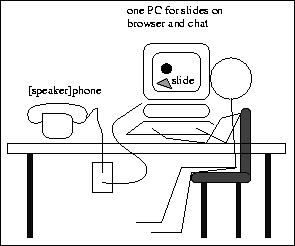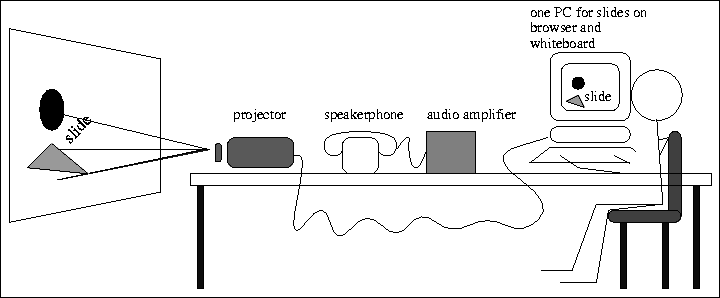| V | S | |
| W |
|
||||
|
|
|
The Virtual Worldwide Seminar is much like a regular seminar, where a sequence of slides is verbally presented by a speaker. The difference between this seminar and regular ones is that the slides are shown over an internet browser, and parties interact over a conference phone call. This allows anyone with a computer and phone to participate, regardless of their physical location. The use of such technology demands that the normal interaction between parties be altered. This webpage describes this regulation. It also describes the Virtual Conference Room, in which Virtual Seminars take place, slides format, and preparation information. Virtual Conference RoomA site refers to each party that dials into the conference call. The Virtual Conference Room requires different resources depending on the number of people at a site, described below. Depending on the number of participants, the room can be an office, a conference room, or even a lecture hall.Single ParticipantIf the site consists of a single person, the Virtual Conference Room collapses considerably. All that is required is a computer with an internet connection, and a separate phone line. Any phone will do, though a speakerphone is best. See Figure 1.
 Multiple ParticipantsWhen there are multiple participants all at one site, more equipment is needed. It is a good idea to elect one person (a "local chair") to put the equipment together, and advance the slides. The extra equipment needed includes a speakerphone, so that everyone may listen in, and a projector, to put the browser display onto a screen. A typical setup is shown in Figure 2. An audio amplifier may be connected to the speakerphone for large audiences.
 Interaction ProtocolDuring a talk, the speaker has absolute control of the phone line. Participants can ask questions only between slides, when the speaker pauses. Participants should identify themselves, as well as their location, before the question. Common sense prevails in the case of many people asking questions all at once.The repartee between speaker and participant may go on until either the participant is satisfied or the speaker decides to take the question off-line. The speaker has the ultimate authority in this decision, and the participant must obey.
The local chair should advertise this interaction protocol
before the seminar to the audience.
The slides should also fit in a typical PC screen, so that no scrolling is needed. Powerpoint slides converted to html is not recommended, as the conversion changes each slide into a huge gif which is slow to download. One optional addition is to have one page with links to all slides in the talk, each with an identifying title and possibly a thumbnail gif. This can help participants refer to slides when asking questions. The local chair is in charge of advancing the slides. It is the speaker's duty to advertise each slide number as he proceeds, to help the participants keep track. Before the Seminar BeginsThe local chair is also responsible for advertising the seminar in his area over relevant email lists, etc. This duty does not apply to single participants.On the day of the seminar, all participants should dial into the conference call 10-15 minutes before the seminar is supposed to begin. (The phone number is emailed out the day before.) Slides should already be pre-loaded into the browser cache. The extra time gives the participants enough time to work out any possible problems (especially audio calibration), and ensures that the seminar start on time. |
